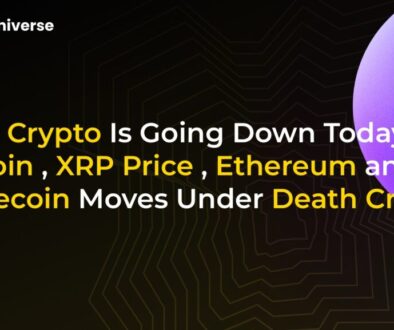Crypto Crash Today: Bitcoin and Ethereum Prices Plummet as Market Loses $100 Billion in Hours. Here’s Why

A Sea of Red: Crypto Market Suffers Massive $100 Billion Drawdown
The cryptocurrency market experienced a sudden and violent downturn today, with its total capitalization shrinking by over $100 billion in just three hours. The flash crash saw flagship assets like Bitcoin (BTC) and Ethereum (ETH) post sharp declines, sending shockwaves through the industry and leaving traders to pick up the pieces. This event serves as a stark reminder of the market’s inherent volatility.
But what caused this sudden financial cliff-dive? Analysts are pointing to a perfect storm of factors, including excessive leverage, macroeconomic pressures, and strategic moves by major players. Let’s break down the key reasons behind today’s major
1. The Leverage Time Bomb: A Cascade of Liquidations
One of the primary culprits behind the rapid price collapse was a massive wave of leveraged liquidations. In cryptocurrency trading, leverage allows traders to borrow funds to increase the size of their positions, amplifying potential profits. However, it also magnifies losses.
Here’s how it unfolds:
- Initial Dip: A small downward price movement, potentially caused by a large sell order or market uncertainty, starts the process.
- Liquidation Trigger: This dip causes highly leveraged long positions (bets that the price will go up) to hit their liquidation points. Exchanges automatically close these positions by selling the underlying assets to cover the loan.
- The Cascade Effect: These forced sales add significant selling pressure to the market, pushing prices down even further and faster. This, in turn, triggers another wave of liquidations from less-leveraged positions.
This domino effect, often called a “long squeeze,” can turn a minor correction into a full-blown market crash within minutes, which appears to be exactly what happened today.
2. Geopolitical Jitters and a Flight to Safety
Cryptocurrencies, particularly Bitcoin, are often viewed as “risk-on” assets. This means investors tend to buy them when they feel optimistic about the global economy and sell them during times of uncertainty. Recent geopolitical tensions have created a classic “risk-off” environment.
Simultaneously, traditional safe-haven assets have seen a surge in interest. Analysts noted a significant uptick in gold prices leading up to the crypto selloff. This inverse correlation is telling: when institutional money gets scared, it often flows out of volatile assets like crypto and into the perceived stability of precious metals. The rising price of gold acted as a canary in the coal mine, signaling a broader market fear that ultimately spilled over into the digital asset space.
3. Whales in Motion: Large Bearish Bets Add Pressure
The crypto market isn’t just driven by retail investors. Institutional traders and large holders, often called “whales,” wield immense influence. Market data suggests that prior to the crash, there was a significant build-up of large bearish bets from these major players.
These sophisticated traders may have anticipated the downturn due to macroeconomic factors or simply aimed to push the price down to trigger the liquidation cascade mentioned earlier. By placing large short orders (bets that the price will fall), they added immense downward pressure that the market couldn’t absorb, accelerating the decline.
What Happens Now? Navigating the Aftermath
For many investors, today’s crash is a painful experience. Fear, uncertainty, and doubt (FUD) are running high. In times like these, it’s crucial to take a step back and assess the situation calmly.
- For Long-Term Holders: Volatility is a known feature of the crypto market. Many long-term believers see these dips as potential buying opportunities, adhering to strategies like Dollar-Cost Averaging (DCA).
- For New Investors: Events like this highlight the importance of risk management. Never invest more than you are willing to lose and avoid making impulsive decisions based on fear.
The market will likely remain choppy in the coming days as it seeks to find a stable price floor. While the


